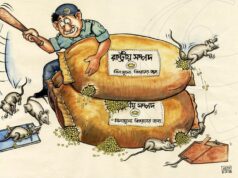I was recently in Chhattisgarh as a member of Joint Review Mission of Centrally Sponsored Scheme of teacher education. This initiative of the Government of India’s MHRD, is a nationwide program for restructuring of teacher education, largely in response to Children’s Right to Free and Compulsory education. I will post my reflections on this experience over the next three days. This first post gives a picture of the considerably slow inclusion of scheduled tribes in the development of the state. And the need for more Inclusive Development Model.The next two: “Restructuring Teacher Education in Chhattisgarh,” and “Schools Remain a Casualty in Dantewada” will outline the challenges the state is facing in restructuring teacher education and provide a snapshot of the education scenario in strife-torn Dantewada respectively.
As I stepped into the provincial capital city of Raipur and then into the district town of Ambikapur, I sensed the global winds of change. Both these towns, in the heart of India, are fast growing urban centers with modern infrastructure. The present state of Chhattisgarh was carved out of undivided Madhya Pradesh in November 2001 and since then it is well on its way to restructuring its new identity. New generation cars sped up and down the roads of these two cities.
I was told by our cab driver, Punjab Singh, a young Maharashtrian fellow, that the prices of real estate had flown meteorically high here due to the entry of many national and international companies. He has benefited from it too, as the value of his recently bought land has become manifold. I checked into Hotel Punjab Palace in Raipur, and later stayed in another hotel in Ambikapur, both owned by immigrants from neighbouring states. Both hotels had internet connectivity, though intermittent and slow.
[Scheduled Tribe population of Chhattisgarh State
is. 6.616,596 constituting 31.8 percent of the total population of the State]
Yet, something seemed amiss. In the midst of my official tours and chats with everyone I met in office spaces and bazaars, I wondered about the lack of visibility of Scheduled Tribes. Their presence did not match their share of 31.8 per cent in the total population. Jugnu, a young man at the office, was always so busy in serving tea and following everyone’s orders that he never had enough time for a chat with me. He was from the tribal community. It appeared that the native population remains disconnected from the overall development and either works as servants and peons in cities or prefers thickly forested areas of the state.
I shared my concerns with a professional at Ambikapur, who came here after the state was carved out from Madhya Pradesh. In a pitying and defeatist tone, she admitted, ‘’Oh! However hard we try to bring them out from forests but they rush back to Jungles at the slightest opening.” Disturbed by her dismissal and the absence of reflection on the apparent unwillingness of the tribal community to participate, I posed my anxiety to a young bureaucrat whom I met at the airport on my way back to Delhi. She had completed her tenure as CDO Ambikapur. In our brief conversation, she said the process of inclusion is always gradual, which provided some reassurance. However, the situation stirred me to listen more carefully to the wind of changes, and reflect on developmentally more rooted and inclusive models that do not drive natives back to forests or are designed to keep them at the bottom of the pyramid.
With the treasure of precious minerals and natural wealth, it remains a dream state for all rewarding commercial activity. The development model then has to respond to aspirations of its residents and not cause their further isolation and marginalization.
Post Disclaimer
The opinions expressed in this essay are those of the authors. They do not purport to reflect the opinions or views of CCS.





